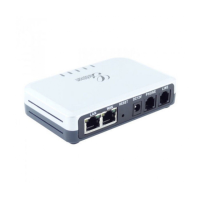
Do you have a question about the Grandstream Networks HT503 and is the answer not in the manual?
| Brand | Grandstream Networks |
|---|---|
| Model | HT503 |
| Category | Telephone Accessories |
| Language | English |
Details significant new features and document updates from version 1.0.15.5.
Lists bug fixes and no new features added in version 1.0.14.1.
Documents new features like Hold Target Before Refer and Crypto Life Time in 1.0.13.3.
Lists the items included in the HT503 ATA package for setup.
Step-by-step instructions for physically connecting the HT503 device.
Highlights advanced telephony features, survivability, and codec support.
Explains how to use the voice prompt menu for basic device configuration.
Covers dialing methods for extension numbers and direct IP calls.
Describes how to place a VoIP call on hold using the flash button.
Explains how to handle incoming calls while already on an active VoIP call.
Details the procedures for blind and attended call transfers.
Guides on how to set up and manage three-way conference calls.
Explains how to use the FXS port for direct PSTN calls and during power loss.
Instructions for making calls from VoIP to the PSTN network, with PIN option.
Guides on making calls from the PSTN to the VoIP network, with PIN option.
How to configure rules to route outgoing calls to the PSTN line.
Method for forwarding VoIP calls to a specified PSTN number.
Process for forwarding incoming PSTN calls to a specified VoIP extension.
Enables direct dialing to PSTN numbers from VoIP extensions.
Describes the supported fax modes, T.38 and fax pass-through.
Steps for configuring the device using its interactive voice response (IVR) menu.
Instructions for accessing and using the web-based graphical user interface.
Details on how to connect to the device's web interface via LAN or WAN ports.
Explains various configuration options and user roles in the web interface.
Procedure for saving configuration changes and applying them to the device.
Method for remotely restarting the HT503 device through its web interface.
Explains automatic device configuration using a central provisioning system.
Guide on upgrading device firmware using TFTP, HTTP, or HTTPS protocols.
Step-by-step instructions for performing a firmware upgrade from a local source.
How to download configuration files via Web Interface or TFTP/HTTP/HTTPS.
Using prefixes and postfixes to manage multiple firmware/config files.
Settings for managing automatic firmware and configuration file downloads.
Overview of methods to reset the device to its original factory default settings.
Procedure for performing a factory reset using the physical reset button.
Steps to reset the device to factory defaults using the IVR voice prompt.
Instructions on how to encode the device's MAC address for IVR reset.